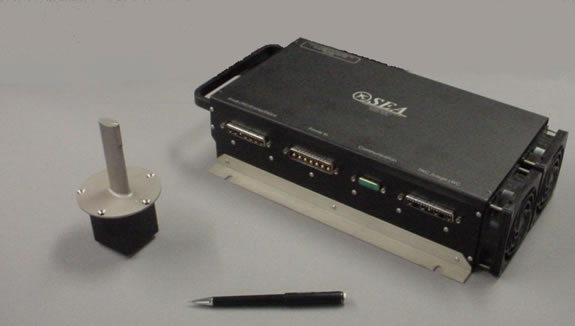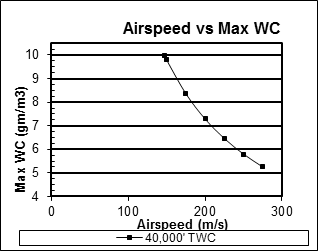WCM-3000 Robust Water Content System
General Description
The SEA Model WC-3000 Robust Water content System was designed to provide aircraft and wind tunnel users with a single, rugged sensor to measure Total Water Content (TWC). The instrument consists of one heated stainless steel element. The element is directly heated by low voltage dc current flowing through the element. The element is maintained at a constant temperature, typically 140 °C, by a digital, closed loop, control system.
Given the dimensions of the element and the true airspeed of the airflow the power level set by the control system to maintain temperature can be converted directly into the water content of the air stream.
The instrument uses a scoop shaped sensor to collect both liquid water (LWC) and ice crystals ( IWC). The combined total of LWC and IWC is referred to as Total Water Content (TWC).
In addition to temperature control for the heated element, the deice system is also temperature controlled. During operation the deice power is adjusted to maintain the instrument housing at a constant 50 °C, which is comfortably warm to the touch. Maintaining the instrument housing at a constant temperature provides a stabilized thermal environment around the sensing elements which leads to improved LWC and TWC measurement accuracies.
Temperature control of the heated elements and the deice heaters allows the unit to be operated safely and continuously at zero airspeed.
The system consists of three major components, the sense head, the power box and the control unit. The sense head is mounted in the air stream. The power box is mounted near the sense head. The control unit is mounted where it is convenient for the user.
The power box for the Robust Head can be redesigned to fit within a standard PMS or DMT canister.
The control unit can be built in many different packages from a standard 19" rack unit that is 4U high to a Zeus rail unit that is 6" x 6" x 10" deep. The control unit can also be imbedded in SEA's M300 DAS.
Documentation
Operating ManualApplications
- Severe Weather Research.
- Cloud Physics Research.
- FAA Aircraft Icing Certification.
- High Altitude, High Speed Ice Crystal Content Measurement.
- Wind Tunnel Spray Measurement.
- Wind Tunnel Reference Instrument.
Features
- Direct Measurement of TWC
- Rugged Sensor Designed for High Speed, High Altitude Operation
- Safe Operation at Zero Airspeed - see endnote [1]
- 28 vdc Power
- Light Weight – 16.5 lbs total weight, excluding cables
- High Water Content Capability
- ASCII Serial Data Output
- Easy Interface to Aircraft Flight Data Computers
- Small Size (Display/Control Unit can be combined with existing Data Systems)
- Measurement over a Wide MVD Range Including SLD drop sizes
- Excellent Deice Performance
- First Principles Instrument for TWC
- Aircraft Icing Severity Indicator
- Detection and Measurements of Ice Crystals especially at High Altitudes and Airspeeds
Specifications
LWC/TWC Range see endnote [2] |
0 - 10 gms/m3 TAS < 150 m/s 0 - 6 gms/m3 TAS < 230 m/s |
Airspeed Range |
0–275 m/s, ( 0–533 kt) |
Measurement Range |
10–275 m/s, (20–533 kt), see endnote [1] |
Power Supply Range |
18–32 vdc, 28 vdc nominal |
Power Consumption see endnote [3] |
3.5 amp minimum 11 amp typical 49 amp maximum |
Sensor Head Dimensions |
3.05 “ x .46 “ x .95” external |
Power Control Box Dimensions |
15.2” x 7.8” x 3.5”* |
Sensor Head Weight |
1.2 lb |
Power Control Box Weight |
12.0 lb |
Total Weight (Excluding Cables) |
13.5 lb |
Data Output |
R3-232/422 ASCII Serial Data. 9600 – 115,200 baud or Ethernet Network TCP/UDP |
Data Update Rate |
Selectable 1 to 20 updates/second |
1 - “Safe Operation” means that the instrument can be left fully powered on continuously at zero airspeed without damage. However as the airspeed is reduced to zero, the effective sample volume decreases to zero and the measurement of LWC is not possible. Depending on the specifics, some minimum airspeed is required to establish a minimum acceptable sample volume. Please contact SEA for details about measurements at very low speeds.
2 - Refer to graph for details. Maximum possible LWC/TWC varies slightly with altitude and is about 10% greater at sea level compared to 40,000 ft at the same airspeed.
3 - Power supply current varies with airspeed, altitude, ambient temperature and water content. Supply currents include deice power. Minimum current is for zero airspeed at 20 °c. Typical current is for 67 m/s, -9 °c, 1.5 gm/m3. Maximum current is for maximum possible LWC/TWC.
 SEA
SEA